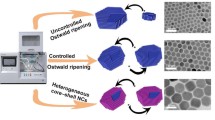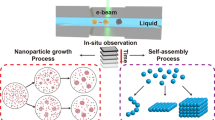Abstract
Purpose
The aim of this paper is to demonstrate that multiple crystal forms can be generated on patterned self-assembled monolayers (SAMs) substrates in single experiments in a given solvent system.
Methods
Functionalized metallic islands are fabricated and utilized as individual templates for crystal formation. Taking advantage of the different wetting properties that patterned surfaces offered, arrays of small solution droplets on the nano- and pico- liter scale were produced on the substrates. Different droplet dimensions were deposited on the substrate. As the solvent evaporates from the droplets, crystals were formed within the constrained volume. Crystal habits were examined with optical microscopy while the solid form was identified with Raman microscopy.
Results
With mefenamic acid (MA) and sulfathiazole as model pharmaceutical compounds, two and four different polymorphs, respectively, were observed under identical conditions. Moreover, it is established that the polymorphic distribution is highly dependent on the solvent evaporation rate and the solution concentration. These results imply that multiple crystal forms competitively nucleate in solution, and the probability of each form nucleating is strongly dependent on the supersaturation of the solution. Additionally, solvent was observed to play a role in controlling the solid state outcome.
Conclusions
Multiple crystal forms can concomitantly nucleate on patterned substrates. This technique can particularly be attractive to screen for polymorphs as elusive, metastable solid forms are favored with the creation of high supersaturation and can be stabilized due to the minimal volumes generated.





Similar content being viewed by others
References
H. G. Brittain. Polymorphism in Pharmaceutical Solids. Marcel Dekker, New York, 1999
J. Bernstein. Polymorphism in Molecular Crystals. Oxford University Press, New York, 2002
A. Y. Lee, and A. S. Myerson. Particle engineering: Fundamentals of particle formation and crystal growth. MRS Bull. 31: 881–886 (2006)
D. Singhal, and W. Curatolo. Drug polymorphism and dosage form design: a practical perspective. Adv. Drug. Deliv. Rev. 56:335–347 (2004)
R. Hilfiker. Polymorphism in the Pharmaceutical Industry. John Wiley & Sons Inc., New York, 2006
(a) Org. Process Res. Des. 7(6):957–1027 (2003); (b) Cryst. Growth Des. 3(6):867–1042 (2003); (c) Cryst. Growth Des. 4(6):1085–1444 (2004); (d) Adv. Drug. Deliv. Rev. 56(3): 235–418 (2004)
H. G. Brittain. Polymorphism and solvatomorphism 2004. In H. G. Brittain (ed.), Profiles of drug substances, excipients, and related methodology, Vol. 32, Elsevier Academic Press, Amsterdam, 2005, pp. 263–283
H. G. Brittain. Polymorphism and solvatomorphism 2005. J. Pharm. Sci. 96:705–728 (2007)
J. D. Dunitz, and J. Bernstein. Disappearing polymorphs. Acc. Chem. Res. 28:193–200 (1995)
J. Bauer, S. Spanton, R. Henry, J. Quick, W. Dziki, W. Porter, and J. Morris. Ritonavir: an extraordinary example of conformational polymorphism. Pharm. Res. 18:859–866 (2001)
A. S. Raw, M. S. Funess, D. S. Gill, R. C. Adams, F. O. Jr. Holcombe, and L. X. Yu. Regulatory considerations of pharmaceutical solid polymorphism in Abbreviated New Drug Applications (ANDAs). Adv. Drug. Deliv. Rev. 56:397–414 (2004)
W. Cabri, P. Ghett, G. Pozzi, and M. Alpegiani. Polymorphisms and patent, market, and legal battles: Cefdinir case study. Org. Process. Res. Dev. 11:64–72 (2007)
G. J. Quallich. Selection of the drug form in exploratory development. In A. F. Abdel-Magid and S. Caron (eds.), Fundamentals of Early Clinical Drug Development: From Synthesis Design to Formulation, John Wiley & Sons, Inc., New York, 2006, pp. 215–246
T. Mukuta, A. Y. Lee, T. Kawakami, and A. S. Myerson. Influence of impurities on the solution-mediated phase transformation of an active pharmaceutical ingredient. Cryst. Growth Des. 5:1429–1436 (2005)
J. Bernstein, R. J. Davey, and J. O. Henck. Concomitant polymorphs. Angew. Chem. Int. Ed. 38:3440–3461 (1999)
A. Y. Lee, I. S. Lee, S. S. Dette, J. Boerner, and A. S. Myerson. Crystallization on confined engineered surfaces: A method to control crystal size and generate different polymorphs. J. Am. Chem. Soc. 127:14982–14983 (2005)
A. Y. Lee, I. S. Lee, and A. S. Myerson. Factors affecting the polymorphic outcome of glycine crystals constrained on patterned substrates. Chem. Eng. Technol. 29:281–285 (2006)
C. S. Towler, R. J. Davey, R. W. Lancaster, and C. J. Price. Impact of molecular speciation on crystal nucleation in polymorphic systems: The conundrum of γ glycine and molecular ‘self poisoning.’ J. Am. Chem. Soc. 126:13347–13353 (2004)
A. Adam, L. Schrimpl, and P. C. Schmidt. Some physicochemical properties of mefenamic acid. Drug. Dev. Ind. Pharm. 26:477–487 (2000)
R. Panchagnula, R. Sundaramurthy, O. Pillai, and S. Agrawal. Solid-state characterization of mefenamic acid. J. Pharm. Sci. 93:1019–1029 (2004)
A. J. Aguair, and J. E. Zelmer. Dissolution behavior of polymorphs of chloramphenicol palmitate and mefenamic acid. J. Pharm. Sci. 58:983–987 (1969)
T. Umeda, N. Ohnishi, T. Yokoyama, T. Kuroda, Y. Kita, K. Kuroda, E. Tatsumi, and Y. Matsuda. Studies on the drug non-equivalence. XIV. A kinetic study on the isothermal transition of polymorphic forms of tolbutamide and mefenamic acid in the solid state at high temperatures. Chem. Pharm. Bull. 33:2073–2078 (1985)
E. H. Lee, S. R. Byrn, and T. M. Carvajal. Additive-induced metastable single crystal of mefenamic acid. Pharm. Res. 23:2375–2380 (2006)
J. F. McConnell, and F. Z. Company. N-(2,3-Xylyl)anthranilic acid, C15H15NO2. Mefenamic acid. Cryst. Struct. Commun. 5:861–864 (1976)
S. Romero, B. Escalera, and P. Bustamante. Solubility behavior of polymorph I and II of mefenamic acid in solvent mixtures. Int. J. Pharm. 178:193–202 (1999)
K. H. Park, J. M. B. Evans, and A. S. Myerson. Determination of solubility of polymorphs using differential scanning calorimetry. Cryst. Growth Des. 3:991–995 (2003)
M. Otsuka, F. Kato, and Y. Matsuda. Effect of temperature and kneading solution on polymorphic transformation of mefenamic acid during granulation. Solid State Ionics 172:451–453 (2004)
S. Hamad, C. Moon, C. R. A. Catlow, A. T. Hulme, and S. L. Price. Kinetic insights into the role of the solvent in the polymorphism of 5-fluorouracil from molecular dynamics simulations. J. Phys. Chem. B. 110:3323–3329 (2006)
J. Anwar, S. E. Tarling, and P. Barnes. Polymorphism of sulfathiazole. J. Pharm. Sci. 78:337–342 (1989)
D. C. Apperley, R. A. Fletton, R. K. Harris, R. W. Lancaster, S. Tavener, and T. L. Threlfall. Sulfathiazole polymorphism studied by magic-angle spinning NMR. J. Pharm. Sci. 88:1275–1280 (1999)
F. C. Chan, J. Anwar, R. Cernik, P. Barnes, and R. M. Wilson. Ab initio structure determination of sulfathiazole polymorph V from synchrotron X-ray powder diffraction data. J. Appl. Crystallogr. 32:436–441 (1999)
A. L. Binghan, D. S. Hughes, M. B. Hursthouse, R. W. Lancaster, S. Tavener, and T. L. Threlfall. Over one hundred solvates of sulfathiazole. Chem. Commun. 603–604 (2001)
N. Blagden, R. J. Davey, H. F. Lieberman, L. Williamsn, R. Payne, R. Roberts, R. Rowe, and R. Docherty. J. Chem. Soc., Faraday Trans. 94:1035–1044 (1998)
S. Khoshkhoo, and J. Anwar. Crystallization of polymorphs: the effect of solvent. J. Phys. D: Appl. Phys. 26:B90–B93 (1993)
N. Blagden. Crystal engineering of polymorph appearance: the case of sulphathiazole. Powder Technol. 121:46–52 (2001)
R. Hiremath, J. A. Basile, S. W. Varnety, and J. A. Swift. Controlling molecular crystal polymorphism with self-assembled monolayer templates. J. Am. Chem. Soc. 127:18321–18327 (2005)
T. Threfall. Crystallization of polymorphs: Thermodynamic insight into the role of solvent. Org. Process Res. Dev. 4:384–390 (2000)
B. Sjoestroem, B. Bergenstaahl, M. Lindberg, and A. C. Rasmuson. The formation of submicron organic particles by precipitation in an emulsion. J. Disp. Sci. Tech. 15:89–117 (1994)
J. L. Hilden, C. E. Reyes, M. J. Kelm, J. S. Tan, J. G. Stowell, and K. R. Morris. Capillary precipitation of a highly polymorphic organic compound. Cryst. Growth Des. 3:921–926 (2003)
J. M. Ha, J. H. Wolf, M. A.. Hillmyer, and M. D. Ward. Polymorph selectivity under nanoscopic confinement. J. Am. Chem. Soc. 126:3382–3383 (2004)
Acknowledgements
Financial support from the U.S. Army Medical Research and Material Command (W81XWH0410864) is gratefully acknowledged.
Author information
Authors and Affiliations
Corresponding author
Rights and permissions
About this article
Cite this article
Lee, I.S., Lee, A.Y. & Myerson, A.S. Concomitant Polymorphism in Confined Environment. Pharm Res 25, 960–968 (2008). https://doi.org/10.1007/s11095-007-9424-z
Received:
Accepted:
Published:
Issue Date:
DOI: https://doi.org/10.1007/s11095-007-9424-z




